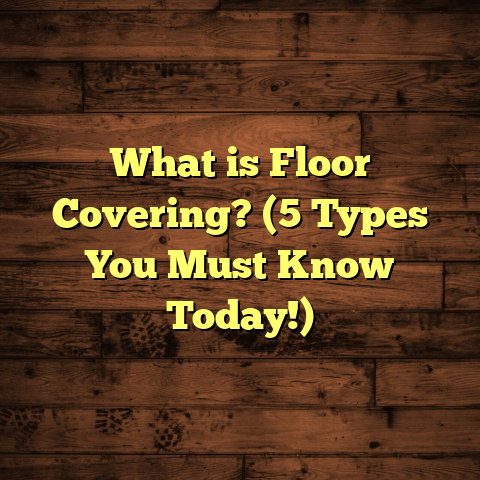What is Floor Mastic? (5 Essential Facts for Homeowners)
Have you ever wondered what really holds your floor tiles or vinyl securely in place? Or why some old floors stay put for decades, while others start peeling or bubbling after just a few years? If you’ve ever faced these questions, then you’ve brushed up against the world of floor mastic. I want to share what I’ve learned about this sometimes-overlooked but absolutely essential product in flooring projects.
What Is Floor Mastic?
At its core, floor mastic is a type of adhesive used to bond flooring materials to subfloors. It’s a thick, paste-like substance that, once applied, holds tiles, vinyl sheets, carpet backings, or other flooring materials firmly in place. Think of it like the glue in your flooring system—but not just any glue. Mastic is specially formulated for floors, designed to withstand foot traffic, temperature changes, and moisture.
From my experience working on various flooring jobs, I’ve seen floor mastic as the backbone of many installations, especially when dealing with vinyl tile or some types of carpet and laminate. It comes ready-to-use in tubs or buckets, so there’s no mixing needed, which is a huge time-saver.
How Does Floor Mastic Work?
The magic lies in its formulation. Floor mastics contain resins, solvents, and fillers that create a sticky yet flexible bond. When you spread the mastic on the subfloor, it starts thick and gooey but dries to a strong yet slightly pliable adhesive layer. This flexibility is key because floors naturally expand and contract with temperature and humidity shifts.
I remember one job where the homeowner was worried about their vinyl peeling off due to extreme weather swings. Using a high-quality mastic designed for moisture resistance made all the difference. The floor stayed solid through winter freezes and summer heat with no lifting or bubbling.
5 Essential Facts About Floor Mastic Every Homeowner Should Know
1. Different Types of Floor Mastic Exist for Different Flooring
Not all mastics are created equal. There are solvent-based mastics and water-based mastics. Solvent-based types tend to be stronger and more resistant to moisture but come with stronger odors and longer drying times. Water-based mastics are easier to clean and less toxic but may not be suitable for all environments.
For example, when installing vinyl composition tile (VCT), I often use a solvent-based mastic because it adheres better and resists peeling in commercial spaces. But for a DIY project with carpet tiles in a living room, water-based mastic works perfectly fine and is safer indoors.
Key takeaway: Always check what type of mastic your flooring manufacturer recommends.
In fact, according to industry data from flooring manufacturers and trade groups, solvent-based mastics provide up to 20-30% stronger adhesion in high-moisture environments compared to water-based products. However, water-based mastics have gained popularity for residential use due to their lower odor and environmental impact.
2. Proper Subfloor Preparation Is Critical
You can have the best mastic in the world, but if your subfloor isn’t clean, dry, and level, you’re asking for trouble. Dust, grease, or moisture can prevent the mastic from bonding correctly. Over the years, I’ve learned that spending extra time preparing the surface saves hours of headaches later.
On one job, we encountered a subfloor with leftover adhesive residue from old carpet glue. We had to scrub and sand it off completely before applying new mastic. Otherwise, the new flooring would have lifted within months.
Here’s a quick checklist I use:
- Sweep and vacuum thoroughly
- Remove any old adhesive or paint
- Check for moisture with a moisture meter
- Fill cracks or holes with patching compound
- Allow everything to dry fully before applying mastic
Subfloor moisture is one of the biggest silent killers of floor adhesives. I recall a case where a client’s floor started peeling just weeks after installation. Moisture testing revealed excess water vapor coming through the concrete slab underneath—a problem that could have been caught beforehand.
To avoid this kind of issue:
- Use a reliable moisture meter before installation
- If high moisture is detected on concrete slabs (above 3 lbs/1000 sq ft/24 hrs), consider moisture barriers or specialized mastics rated for these conditions
3. Application Techniques Influence Longevity
Applying floor mastic isn’t just slapping it down; technique matters. Most manufacturers recommend using a notched trowel to spread an even layer. The size of the notches depends on the flooring type—larger tiles usually need more adhesive coverage.
In my early days, I made the mistake of applying too thin a layer on vinyl tiles. The tiles later popped up at the corners because there wasn’t enough adhesive holding them down. Since then, I always follow manufacturer guidelines strictly.
Also, working in sections helps avoid premature drying before you set the flooring material on top. Mastic typically has an “open time” window—how long you have before it starts drying but hasn’t fully cured yet.
For example:
- When installing vinyl tile using a 1/16” notched trowel, make sure coverage is at least 90-95% of the tile back
- For carpet tiles with rough backing, a thicker layer might be necessary
I’ve also learned that temperature affects application ease and curing speed—very cold rooms slow down drying times significantly.
4. Drying and Curing Times Vary
How long does floor mastic take to dry? It depends on the product and conditions like temperature and humidity. Usually, initial drying takes a few hours, but full curing (when it reaches maximum strength) can take from 24 to 72 hours.
From my projects, I’ve learned that rushing this phase leads to problems down the road—tiles lifting or edges curling up because the adhesive wasn’t fully set.
Here’s a rough guide based on typical mastics:
- Solvent-based: tacky in 2-4 hours; cure in 48-72 hours
- Water-based: tacky in 30 minutes to 1 hour; cure in 24-48 hours
I always tell homeowners to plan around these drying times before walking heavily on new floors or moving furniture back into the room.
If you’re wondering about ventilation during this period: good airflow helps speed curing and reduces lingering odors from solvent-based mastics.
5. Mastic Can Affect Indoor Air Quality (So Choose Wisely)
This one surprised me when I first started working with floor adhesives. Some solvent-based mastics release strong fumes during application and drying. These VOCs (volatile organic compounds) can cause headaches or respiratory irritation if ventilation is poor.
Luckily, many modern mastics are low-VOC or even zero-VOC formulas designed for safer indoor use. For projects inside homes—especially where kids or pets live—I prefer using these greener options.
One interesting study I came across showed that switching from solvent-based to water-based mastics reduced indoor VOC levels by over 80%. That’s huge if you’re sensitive to smells or chemical exposure.
In addition to low-VOC mastics:
- Use fans or open windows during and after installation
- Consider air purifiers if you’re extra sensitive
Why Floor Mastic Is So Important: My Personal Take
I’ve been in countless homes where the difference between a solid floor and a problem floor boiled down to the adhesive used. One memorable project involved an older home with hardwood floors overlaid by vinyl tiles glued down decades ago with inferior adhesive. The tiles were bubbling and peeling everywhere.
We removed the old tiles and adhesive carefully, prepped the subfloor meticulously, then applied a premium solvent-based mastic recommended for historic renovations. The vinyl went down flawlessly and stayed perfect for years afterward.
That experience taught me that investing in the right mastic upfront saves money on repairs later on—and makes your floors last much longer.
How I Use Tools Like FloorTally to Manage Costs
When I’m planning flooring jobs for clients or my own home projects, estimating cost accurately is always a challenge. That’s where tools like FloorTally come in handy for me.
I plug in details like:
- Room dimensions
- Flooring type
- Material costs
- Labor rates
- Waste factor for leftover materials
FloorTally then gives me a clear cost breakdown quickly without multiple back-and-forth quotes. This helps me set realistic budgets and avoid surprises halfway through installation.
For example, when budgeting for mastic and tile installation in a kitchen remodel, FloorTally showed me how much mastic volume was needed considering waste—so I didn’t buy too little or too much.
If you’re working on DIY flooring or managing contractors, such tools can save both time and money by simplifying calculations that are tedious otherwise.
A Quick Case Study: Vinyl Tile Installation Using Floor Mastic
Let me share a recent case study from my own work:
Project: Installing vinyl composition tile (VCT) in a mid-sized office space
Area: Approximately 800 square feet
Challenge: Subfloor had minor unevenness and previous adhesive residue
Solution:
- Removed old adhesives completely
- Levelled subfloor using patching compound
- Applied solvent-based floor mastic with a 1/16” notched trowel
- Laid VCT tiles carefully within 30 minutes open time window
- Allowed 48 hours curing before foot traffic
Outcome:
- Tiles adhered firmly with no lifting after 1 year
- Floor remained stable despite seasonal humidity changes
- No VOC complaints from office staff due to proper ventilation during application
This project reinforced how critical mastic choice and application quality are to success.
Deepening Our Understanding of Floor Mastic
The Chemistry Behind Floor Mastic
You might ask: what exactly goes into floor mastic that makes it so special? The answer lies in its chemistry—and this affects performance dramatically.
Most mastics are based on synthetic resins like acrylics or rubber-based compounds mixed with plasticizers and solvents or water as carriers.
Acrylic-Based Mastics
Acrylic mastics are popular because they offer good adhesion with flexibility and low odor (especially water-based acrylic mastics). They dry by water evaporation.
They work well for:
- Vinyl flooring
- Carpet tiles
- Some laminate applications
Rubber-Based Mastics
Rubber-based mastics often have stronger bonding power and better resistance to moisture but usually involve solvents that release strong smells during drying.
They’re ideal for:
- Vinyl composition tiles (VCT) in commercial spaces
- Areas where moisture resistance is critical
Learning about these chemical differences helped me choose adhesives more wisely over time—whether for residential comfort or commercial durability needs.
Environmental Impact and Sustainability of Floor Mastics
Flooring is increasingly judged by its environmental footprint—and adhesives play their part here too.
VOC Emissions
As mentioned earlier, traditional solvent-based mastics emit volatile organic compounds (VOCs), which contribute to indoor air pollution and smog outdoors.
Switching to low-VOC or no-VOC water-based mastics reduces health risks during installation and improves indoor air quality immediately afterward.
Disposal Concerns
Leftover mastic must be disposed of properly since some contain solvents harmful to soil and water systems if dumped improperly.
I always advise clients on:
- Purchasing only what’s needed (using tools like FloorTally)
- Following local hazardous waste disposal rules
This approach minimizes waste and environmental impact while keeping projects cleaner overall.
Troubleshooting Common Issues with Floor Mastic
Even with care, problems sometimes happen post-installation. Here are some common issues I’ve seen—and how you can handle them:
Tiles Lifting or Peeling
Causes: Poor subfloor prep; incorrect mastic type; insufficient adhesive coverage; high moisture levels.
Fixes: Remove loose tiles; clean subfloor thoroughly; reapply correct mastic; allow full cure before traffic.
Bubbling or Wrinkling Floors
Causes: Moisture trapped under tiles; improper drying time before installation; excessive heat exposure after installation.
Fixes: Test moisture levels pre-installation; ensure recommended open time is followed; avoid placing floors near heat sources initially.
Strong Odors Post-Installation
Causes: Use of solvent-based mastic without proper ventilation; product off-gassing longer than expected.
Fixes: Increase airflow using fans; open windows; consider air purifiers; next time select low-VOC products if sensitive.
Personal Anecdote: When Mastic Saved a Historic Home Renovation
Years ago, I worked on restoring a historic home where original hardwood floors had been covered by old vinyl tiles glued down poorly decades ago. The old glue was failing badly—tiles were loose everywhere.
We had two challenges:
- Preserve as much original hardwood as possible without damage
- Install new flooring that could handle both modern use and historic building quirks
After careful subfloor prep removing all old adhesive residue by scraping and sanding, we chose a premium solvent-based mastic rated for historic restorations—offering strong bonding plus some flexibility for natural wood movement.
The new vinyl tile installation went smoothly without future lifting issues even two years later when I last checked back. The homeowner was thrilled that we saved their floors both functionally and aesthetically.
Cost Considerations When Using Floor Mastic
Costs vary depending on product type, brand, quantity needed, labor rates, etc.
Material Costs
Floor mastic typically costs between $15-$50 per gallon depending on quality and formulation (water vs solvent based).
On average:
- A gallon covers roughly 150–200 sq ft depending on trowel size
- For an average room around 300 sq ft, expect about $30-$60 for mastic alone
Labor Costs
Labor varies regionally but installing flooring with mastic generally adds about $1-$3 per sq ft including surface prep and adhesive application.
Total Budgeting Tips
When budgeting:
- Factor extra materials for waste (~5%-10%)
- Include subfloor prep costs (patching compounds etc.)
- Consider rental equipment if sanding or grinding needed
Using tools like FloorTally helped me keep these numbers precise—so clients never face sticker shock mid-project.
Final Thoughts: Should You Use Floor Mastic?
If you’re planning to install floors like vinyl tile, carpet tiles, or even some laminates, floor mastic is usually part of the equation. It’s what keeps your floors grounded—literally!
Ask yourself:
- What type of flooring am I installing?
- What adhesive does the manufacturer recommend?
- Is my subfloor ready for adhesive?
- How much drying time can I allow?
- Are there ventilation concerns during application?
Answering these helps you pick the right mastic and get your floors done right.
And if you want to stay organized while managing costs and materials, tools like FloorTally can make your life easier.
If you ever want to chat more about your specific flooring plans or challenges with adhesives, just ask—I’ve probably seen it before!
By sharing these insights and personal stories about floor mastic, my goal is that you feel more confident tackling your next flooring project— whether doing it yourself or working with pros. Floor mastic might seem simple at first glance, but it plays a big role behind the scenes in making sure your floors stay beautiful and secure for years to come.





